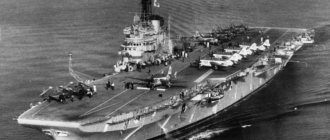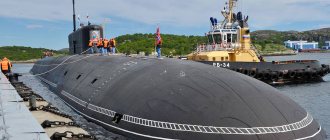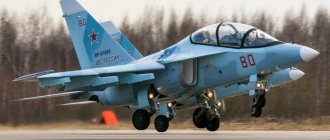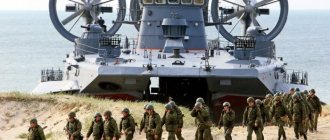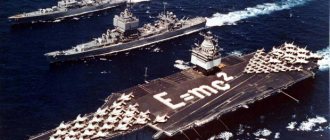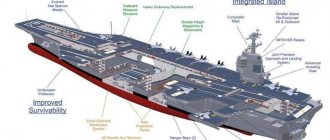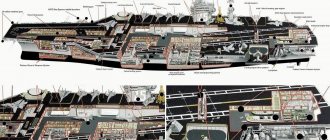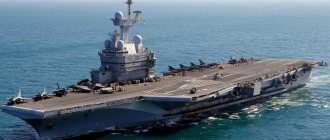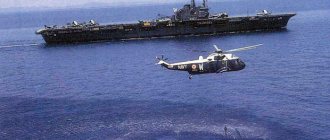An aircraft carrier is not just a big ship, it is a serious argument on the world stage. It is no secret that Russia has only one ship of a similar class - an aircraft-carrying cruiser, but another one should appear soon. Among the most controversial projects of the Russian military-industrial complex now is the development of a new aircraft carrier, Project 23000 “Storm”. The vessel will acquire the status of a multi-purpose heavy vessel, or there is an option to create a TAVKR.
Computer model of the newest aircraft carrier
Reasons for creating a new aircraft carrier in Russia
The main reason why Russia began to develop a new aircraft carrier is not even the obsolescence of the existing TAVKR. “Admiral Kuznetsov” began combat duty in 1987, which means it was barely in its 30s. The technical condition at the moment is satisfactory and it is capable of effectively performing combat missions, as we were able to verify during participation in the Syrian conflict.
The ship being developed will be able to solve the following tasks:
- striking at the ground and sea targets of the alleged enemy in the far ocean zone;
- air defense by means of the aviation group and its own airborne weapons;
- providing support during landings.
In addition, Navy aircraft carriers can perform an important role even outside of a state of war. According to conflicting data that is periodically received about the ship, it is designed to be able to overcome expanses of water with a significant thickness of ice on the surface. This will allow it to be used to defend interests in the Arctic Ocean if necessary.
Experts note that one ship is not enough; the Russian fleet needs at least four:
- 2 for the Northern Fleet;
- 2 for the Pacific.
It is assumed that in this case one ship could be on combat duty, while the second, meanwhile, could be in repair docks or undergoing modernization. It is necessary to use TAVKR in certain strategic zones that affect Russian interests.
Design and technical characteristics of the future flagship
The development of the AVM (multi-purpose aircraft carrier) was carried out by the Krylov State Research Center, the first model was demonstrated in 2013. The prototype was presented to the general public in 2015. Development was carried out under the code “Lair”.
"Storm", characteristics
According to the main parameters of the project, the length of the vessel will be about 330 meters, width - 40, draft within 11. Displacement within 100 thousand tons. To assign an ice class, appropriate equipment and adaptation of the systems used will be required to operate in polar latitudes.
The power plant will be a combined nuclear reactor, however, the original project was created for conventional engines. In the first case, RITM-200 reactors will most likely be used, which are expected to be tested on the icebreaker Arktika. The power of the power plant is estimated at 200 thousand horsepower.
A noticeable difference from the classic layout of aircraft-carrying ships is the absence of a massive tower. Instead, two separate islands will be created, occupying much less space on the deck.
First mockup demonstrated
The deck superstructures of the newest Russian aircraft carrier will accommodate:
- command bridge;
- observation posts;
- means of communication;
- radio-electronic systems.
There will be 4 launch positions prepared on the flight deck, the equipment will include 2 ramps as a springboard, 4 electromagnetic catapults. An aerofinisher will be used for landing; there will only be one.
New Russian aircraft carrier: Project “Priboi” in Kerch is developing into a light “Storm” before our eyes
Something unimaginable, at first glance, is happening with the newest Russian universal landing ships (UDC) “Ivan Rogov” and “Mitrofan Moskalenko” (project 23900, code “Priboy”), solemnly, in the presence of President Vladimir Putin , laid down at the Kerch shipyard in July 2020. If you try to analyze reports about this project at least over the last year and a half, it is difficult to understand: what, exactly, are we actually building there?
Let's remember. Less than a year before the start of work in Kerch, on September 11, 2022, TASS, citing two sources in the shipbuilding industry, said: “Two UDCs with a displacement of up to 15 thousand tons, for the first time in the history of Russia, are planned to be laid down at the Zaliv shipyard in Kerch in 2022,” said one of the agency’s interlocutors... Another source clarified that “the laying of both ships will take place in May 2022.” He confirmed that the displacement of each will be up to 15 thousand tons. The ships, he said, will be able to carry on board more than 10 helicopters of various classes, and will also receive a large docking chamber for landing boats.”
Main weapons
American aircraft carriers are not capable of independently repelling large-scale attacks from air and water. The Russian development, by analogy with the Admiral Kuznetsov, must cope with enemy attacks on its own, including through carrier-based aircraft.
The group on board will include between 70-90 units, among them:
- Su-57 multirole fighters;
- Su-33M;
- Su-35K;
- MiG-29K;
- MiG-29KUB;
- long range radar detection aircraft;
- anti-submarine/multipurpose Ka-27;
- Ka-25;
- Ka-28;
- Ka-29;
- Ka-31;
- Ka-52K.
It is assumed that takeoff and landing can be carried out even in storms of 6-7 points.
The ship's missile defense system is supposed to be equipped with 4 anti-aircraft missile systems with vertical launch of missiles. Perhaps it will be equipped with shipborne versions of the S-500 air defense system. This system will be able to combat aerodynamic and ballistic targets moving at speeds of up to 7 km/s at a distance of up to 800 km.
To combat torpedoes, 2 anti-torpedo installations will be used.
The electronics complex will use radar stations with an active phased antenna array and many sensors.
General view of the aircraft carrier
The total ammunition is estimated at 3,000 cruise missiles and aircraft bombs.
Crew - 4000 people.
Aircraft carrier "Storm": the project of a super-class ship will cost 350 billion
If the project does not change, it will become one of the three largest aircraft carriers in the world. Photo: Petr Kovalev/TASS
The USSR Navy had 7 heavy aircraft-carrying ships; after the death of the Union, Russia was left with only one “Admiral Kuznetsov”. The rest were sold or melted down. For many years, the Russian Ministry of Defense has been talking annually about the desire to create a “full-fledged” aircraft carrier for our Navy. But things didn’t go further than talk. And finally, the issue has been put on a “practical footing” - there is the Storm aircraft carrier project.
The design of a new Russian aircraft carrier was included in the state armament program until 2025. Vice Admiral Viktor Bursuk, Deputy Commander-in-Chief of the Russian Navy for Armaments, stated this at the recent International Naval Show in St. Petersburg.
WHO DESIGNS THE SHIP?
The Storm aircraft carrier project is being developed by the Krylov State Research Center (St. Petersburg). It is a leading research and development organization in the shipbuilding industry. In Soviet times, super-class ships (aircraft carriers, nuclear submarines, icebreakers). Specialists from the Nevsky Design Bureau also participated in the development of the current project.
WHAT WILL THE STORM BE?
The Krylovites gave the project a name - “Storm” (the project, but not the ship). The developers believe that the aircraft carrier should have a big name - “Marshal Zhukov”.
If the project does not change, it will become one of the three largest aircraft carriers in the world (after the American Nimitz and Gerald Ford).
The deck is the size of three football fields. Displacement - about 100 thousand tons. Length - 330 m, width - 40 m, speed - 30 knots. It will have a combined power plant - nuclear and gas turbine. What's the trick? Valentin Belanenko, head of the planning department for advanced surface ship projects at the Krylov Center, answers:
“This will allow the ship to quickly leave its location at the speed of a boat, and then along the way you can launch a nuclear power plant. The battery life is 120 days. Ammunition - hundreds of bombs, cruise missiles and anti-torpedoes. Crew - 4000 (!) people.
There are two launch systems on the flight deck: two traditional trampoline tracks and two electromagnetic catapults. Aircraft landing will be ensured by one aerofinisher. The composition of the air group (fighters, helicopters and reconnaissance aircraft - at least 90 units). Air defense - four anti-aircraft combat modules (promising shipborne versions of the S-500 air defense system are expected). Anti-torpedo defense has also been designed for underwater protection.
The design of a new Russian aircraft carrier was included in the state armament program until 2025. Photo: Petr Kovalev/TASS
WHAT IS THE FLOATING AERODROME?
Experts say: if our aircraft carrier began to be built today, its development and creation
(plus weapons and aircraft) would cost the state treasury approximately 350-360 billion rubles. That is, $6 billion. But it is not yet known exactly when the Storm will begin to be built (and construction will take 8-9 years).
The US Nimitz-class nuclear-powered aircraft carrier also cost $5 billion. This, as experts say, is the average world price. But the Pentagon paid as much as $13 billion for the newest aircraft carrier USS Gerald R. Ford. It is considered the most expensive warship in the world. And the malicious English media are already estimating that our “Storm” will be even more expensive - about $17.5 billion.
Considering the high cost of creating a full-size aircraft carrier with the specified performance characteristics, the Krylov Center has begun proactive development of the technical specifications for a simpler “light” aircraft carrier, with combat capabilities not much inferior to the “Storm”, but with a lower price.
DOSSIER "KP
Today, 10 countries have aircraft carriers. The USA has 11 such ships. Second place was shared by Italy, Spain and China - two aircraft carriers each. Russia, France, Brazil, India, Thailand, and Great Britain have one each.
WHERE WILL THEY BUILD?
The head of the United Shipbuilding Corporation, Alexei Rakhmanov, believes that the most likely place is the Baltic Shipyard. The second option is OJSC Sevmash in Severodvinsk. Crimean Kerch is not excluded.
There are two launch systems on the flight deck: two traditional trampoline tracks and two electromagnetic catapults. Photo: Petr Kovalev/TASS
ARCTIC SIGHT
According to the project, our multi-purpose aircraft carrier will be of the ice class. It is planned to ensure that the vessel is suitable for performing combat missions in both warm and cold latitudes. And the appearance of “Storm” in the Arctic will be a compelling argument in disputes with opponents...
PROFESSIONAL OPINION
“We didn’t take our eyes off such “objects””
I talked about aircraft carriers with the former first deputy chief of the Main Staff of the Russian Navy, Vice Admiral Oleg BURTSEV .
— Why did we abandon aircraft carriers after the fall of the USSR?
— Formally, there was no refusal, but the economic situation in the country did not allow building new ships and maintaining old ones. You know the tragic fate of Minsk and Novorossiysk - our first aircraft carriers.
-What happened to them?
“They did several combat services, and were withdrawn from combat service due to lack of funding.
— What was the fate of “Moscow” and “Leningrad”?
— These were our first helicopter carriers. They served their entire term and were scrapped.
- Why did we fail with aircraft carriers?
— The reason is not only economic. The failure of such ships began after Khrushchev’s decisions. When we reorganized everything to produce missiles, deciding that they were a panacea for all problems, including at sea. It turned out not. The aircraft carrier advanced during the Second World War and dramatically showed who was boss at sea. And battleships were already guarded by aircraft carriers at the end of the war, and not vice versa. But in the late 50s and 60s we changed our doctrinal positions, placing emphasis on the cruise missile. As a result, large ships were scrapped.
— Why did projects for a new aircraft carrier appear now?
— The fleet cannot consist of only battleships or only nuclear submarines. The fleet must be a balanced unit. The Navy is a mini-military force. There should be aircraft carriers, and aviation - it is now one of the main strike forces at sea.
— How can you hit someone else’s aircraft carrier today?
— An aircraft carrier does not have to be sunk; it can be damaged to such an extent that it will not be able to use aircraft. For this we have a cruise missile. Now they are writing about Zircon. When I commanded a fleet of submarines, I had Granites. A very serious weapon. And these missiles had a target - namely, large ships, no less than a destroyer. And it was believed that Granit could be used effectively against aircraft carriers. But there are also torpedoes. US officers admitted that they looked at our so-called thick 65-76 torpedoes, which sounded so loudly at the time of the death of the K-141 Kursk submarine, with great apprehension. Its range, charge, and speed made it possible to effectively use it against an aircraft carrier.
— So, with the proper use of our weapons, any foreign aircraft carrier can be hit?
- Certainly. The fact is that naval science provides for such a form of warfare as a naval operation. That is, it is carried out in cooperation of all types and arms, excluding strategic missile forces. I mean submarines, surface ships and aircraft. They are able to operate effectively against aircraft carriers.
- Can you get them from the shore?
— The weapon must have a good range. The enemy will not come to such a distance that it will be dangerous for him. He knows our firing range.
Now we have territorial waters. And there was a cannon right - as far as a cannon can shoot, that’s mine too.
Aircraft carrier "Storm"
Photo: Dmitry POLUKHIN
— There is a project for a new aircraft carrier “Storm”. And the timing of its appearance is called - between the 25th and 30th year. Are these calculations real?
- I think yes. The Commander-in-Chief of the Navy, Admiral Vysotsky, paid a lot of attention to this. Everything comes from there, these studies, technical solutions.
“Recently, our experts assessed the newest American aircraft carrier and said that it has different catapults.
— Electromagnetic catapults.
- What are their advantages?
- There are steam catapults - this is when the plane clings to a hook, let's say. The steam catapult accelerates it to speed when it has lift plus speed. It's the same thing here, just an electromagnet is used instead of a steam system.
— Is the Russian defense industry capable of solving the same problem?
- I think yes.
— Where will we build a new aircraft carrier?
— All our previous aircraft carriers were built in Nikolaev. I think that St. Petersburg and Severodvinsk are two centers where it is possible to build ships of the appropriate displacement and size.
— How can the appearance of an aircraft carrier raise the status of our Navy?
— The presence of an aircraft carrier dramatically increases the combat stability of a group operating in a separate direction, in remote areas. The aircraft carrier must be protected. There are special security ships for this. But he, naturally, with his aviation protects the entire group, which is able to deliver a corresponding blow. There is such a concept in the order of ships - the core. For example, this is a cruiser armed with missiles, plus an aircraft carrier. This is a guarded center that influences the enemy most effectively.
“Now American aircraft carriers are flying everywhere. Do they carry a large brood of security ships with them?
— 8-10 ships. The aircraft carrier is surrounded by escort ships, for example, destroyers, frigates. Even in the core there may be a cruiser, a submarine, and also special search groups that move to a threatened direction, for example, with the task of timely detection of our submarines.
— Did Vice Admiral Burtsev, when he commanded a flotilla of submarines, have to chase aircraft carriers?
— Each aircraft carrier is a carrier of nuclear weapons, plus 90 aircraft. This is an aviation division. Enemy ships were always monitored. To be able to forestall the enemy. We never took our eyes off such “objects.” Both on the water and under the water...
MEANWHILE
It became known that in addition to the aircraft carrier, two helicopter carriers were also included in the state armament program for 2018-2025. The first, according to Deputy Minister of Defense of the Russian Federation Yuri Borisov, will enter the combat formation of the Navy around 2022, the second - five years later.
The basis of the air group on these ships will be. Ka-52K helicopters. There will also be Ka-27, Ka-29, Ka-31.
The helicopter carriers will have a combined diesel-gas turbine unit.
What ships are currently in service with the Russian Navy?
"Admiral Kuznetsov", although multi-functional, is capable of repelling massive air attacks, but does not have equipment to combat ships. Optionally, this possibility exists, but in fact, anti-ship missiles were fired from the ship only during tests in 1994. It is expected that this facility will be re-equipped in the next modernization.
The construction process of the aircraft carrier "Admiral Kuznetsov"
After the Syrian conflict, rumors began about the imminent decommissioning of the TAVKR, but the information was clearly exaggerated. The machine still has enormous potential and it successfully copes with its assigned tasks. In addition, even in comparison with the American fleet, the Russian aircraft-carrying cruiser is not that old and is in satisfactory technical condition.
Tales of Power
Further more. When seriously considering the prospect of building aircraft carriers in Russia, we are immediately faced with the lack of a number of key technologies and elements for the construction of such ships. Let's start with the fact that we still do not have our own aircraft catapult technology. In the late 80s we were engaged in their creation, but the collapse of the Union put an end to this work. But a catapult is the most important element of a modern aircraft carrier and a whole bunch of technologies. Not only the lives of the pilots, but also the success of the mission depends on the reliability and performance of the catapult. If even one of the four (as on American aircraft carriers) catapults fails during a combat operation, it reduces the ship’s combat effectiveness by a quarter, and the failure of two will simply disrupt its implementation. Today on the TAVKR “Admiral Kuznetsov” the role of a catapult is played by the “beard” of the springboard. But only fighter planes can fully take off from it. Attack aircraft can take off only with a limited bomb load, and AWACS aircraft, without which the carrier force today is simply blind, simply will not take off from the springboard.
At the same time, domestic carrier-based AWACS aircraft themselves simply do not exist in nature, and no design work is being carried out on them. Just as there are no modern carrier-based attack aircraft. There is only the carrier-based MiG-29K, hastily completed for India, based on the MiG-29 fighter, whose flight age has long exceeded forty years.
An equally important problem is the basing of domestic aircraft carriers. Where should they be based? Russia does not have its own military bases that are “comfortable” in terms of weather conditions, except for the Black Sea ones. But the way there for ships with a nuclear power plant is closed by an international treaty. In addition, the Black Sea is simply a trap for such giants. Neither the Northern nor the Pacific Fleet have a single berth suitable for ships of this type with the necessary infrastructure and equipment. Therefore, “Admiral Kuznetsov” today is based at the wall of the 35th ship repair plant in Murmansk, where there is everything for its life support.
In the 80s, it was the lack of coastal life support infrastructure that led to the fact that the aircraft-carrying cruisers of Project 1143 were decommissioned without serving even half of their standard life. They simply “knocked out” their resource, constantly based at sea on barrels, until their systems and mechanisms were completely worn out.
We can also recall the problem of training crews for such ships. There is no domestic “school” of aircraft carrier fleet today. There is only one crew of the Admiral Kuznetsov. But the promising aircraft carrier is almost twice as large and, accordingly, its crew is also almost twice as large as the Kuznetsov. This means that it will be necessary to build new military camps, not to mention the coastal infrastructure for basing such giants in the Far North. But even if a decision is made to build them, Russia needs at least two of these ships.
When will the new aircraft carrier enter service?
Construction is expected to start in 2025-30, the cost is currently estimated at 350 billion rubles. It is worth noting that equipment and some aspects of the project may change repeatedly at any stage of implementation. The assembly process itself will take about 8-9 years
The development of the first Russian nuclear-powered aircraft carrier will take place in 2023. It is expected to be called “Marshal of the Soviet Union Zhukov.” Construction will probably begin at the Zvezda Far Eastern shipyard in the city of Bolshoi Kamen.
